Re: The Gilpin Tram in Black Hawk
Posted by Keith Pashina on Oct 30, 2023; 9:39pm
URL: http://c-sng-discussion-forum.254.s1.nabble.com/The-Gilpin-Tram-in-Black-Hawk-tp18436p19189.html
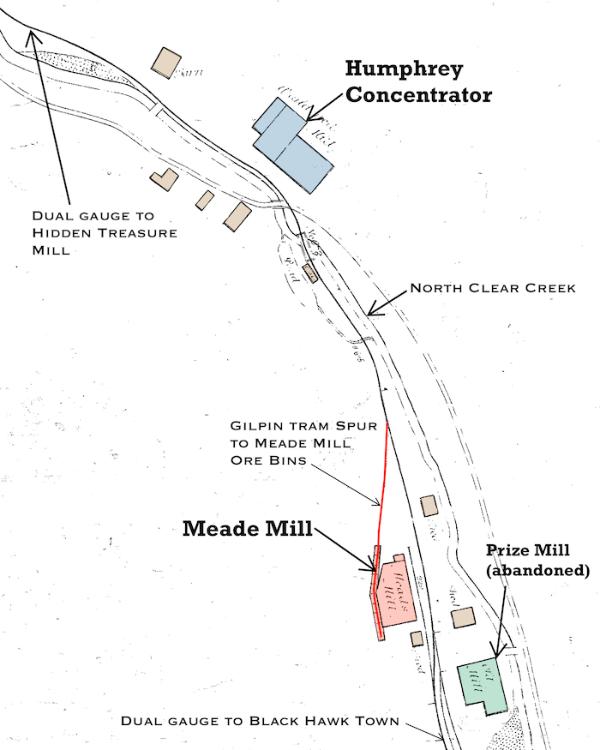
This map shows the details of the area around the Humphrey and Meade Mills
Next, we come to the Meade Mill. The Meade Mill was another mill that was constructed before the railroads were built, and expanded over the years. As the Gilpin Tram was being built, the mill owners modified the mill to put metal sheeting over the wooden ore bins, and had a spur built to serve the elevated bins. This mill received the first ore loads shipped over the Gilpin Tram, from the Gunnell Mine on December 11, 11887, when six ore cars were shipped to the mill.
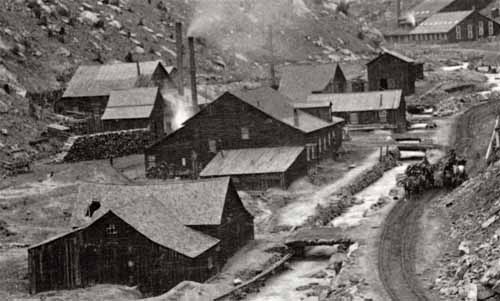
In this pre-railroad photo, the Meade Mill is the building with the smoking stack in the center of this photo. Several additions were constructed over the years on this building. This photo is from the Denver Public Library, Western History Collection, image X-60795
Another incident was reported in 1888, when a runaway ore car in what must have been an exciting accident. The runaway ore car, which had been unloading ore at the Hidden Treasure Mill, ran downgrade to the Meade Mill, where the runaway ore car struck a wooden ore wagon, demolishing it, killed one and injured the other mule, then when on to strike another GT ore car loaded with ore. This collision released the second ore car’s brakes, and the two runaway cars continued on to near the Polar Star Mill, where they struck a UPD&G 3’ gauge boxcar before everything finally came to a stop!
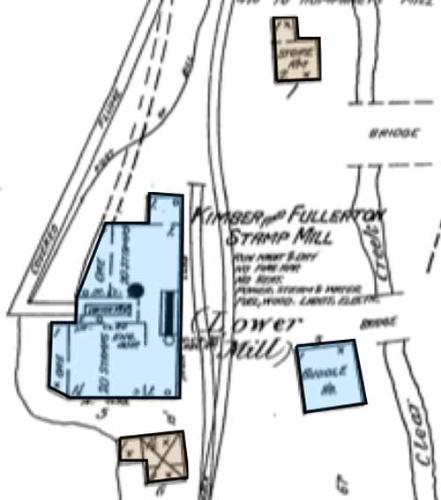
The 1890 Sanborn Fire Insurance map shows the Meade Mill. The map doesn't show it, but the Gilpin Tram spur ran parallel to the double dashed lines (water flume for water wheel) and dumped into the ore bins
The Meade Mill was sometimes referred to as the Fullerton, Gunnell and Kimber and Fullerton Lower Mill as various times. The mill building housed 40 stamps, powered by a water wheel seasonally, and a boiler and steam engine the remainder of the year. There was also a separate buddle house across the tracks.
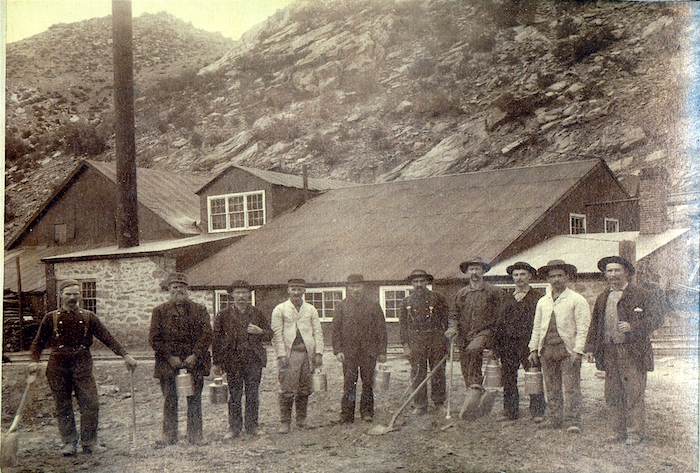
This image shows the Meade Mill, from the creek side sometime in the late 1890s and before 1902. The Gilpin Tram Era Sundance book has a series of three photos taken at about the same time showing more details of this mill. I think this would be an interesting structure to model - I like the combination of stone, wood, and metal-clad walls, and varied roof lines. Nothing remains of the mill or its site today, due to more recent highway and water drainage construction. Photo courtesy of the Mark Baldwin collection.
There is a record of 27 ore cars being shipped to the Gunnell Mill in September 1906, but that could have been this mill or another operation using the Gunnell name at the time. I could not find any records of any other shipments to this mill after this date.
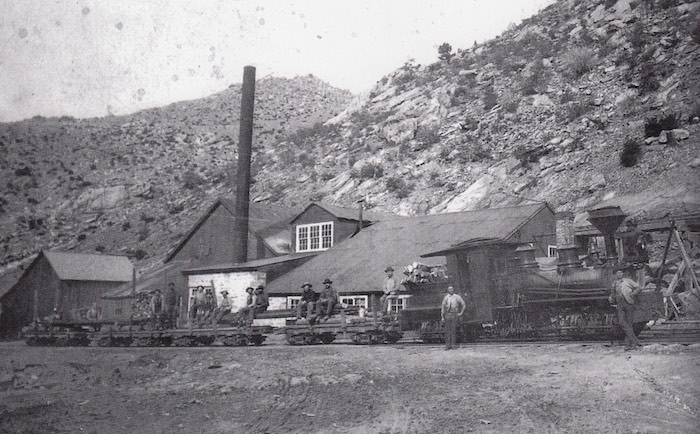
This photo is from the Gilpin Railroad Era by Sundance Publications, and shows Shay #1 and a work train in front of the Meade Mill. The Meade Mill was a conglomeration of several building styles, and would make a very appealing model
As we continue our visit down along Clear Creek, we round a bend and approach a very fascinating area - the location of the transfer tracks between the Gilpin Tram and C&S, and further downstream, the Polar Star and Eagle Mills. The main part of Black Hawk becomes visible in the distance.
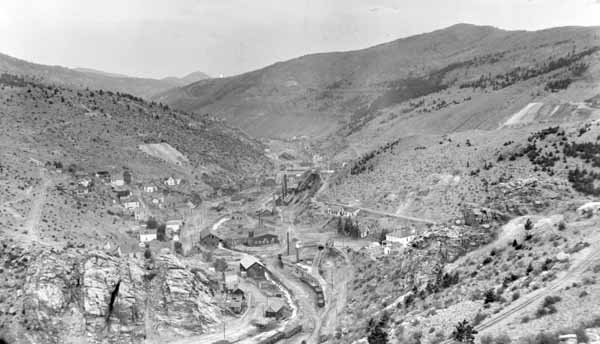
Here is a great view from the Denver Public Library, Western History Collection, showing a view of Black Hawk looking south. Lots of detail can be seen in this view
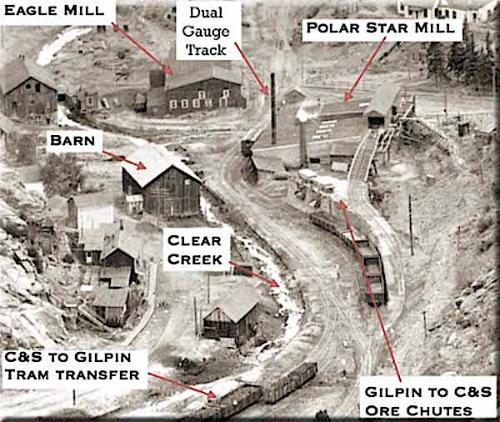
Here is a key to the photo above, identifying the areas of interest
I will pause for now, but in the next posts, we will examine this area in detail.
'all for now!
URL: http://c-sng-discussion-forum.254.s1.nabble.com/The-Gilpin-Tram-in-Black-Hawk-tp18436p19189.html

This map shows the details of the area around the Humphrey and Meade Mills
Next, we come to the Meade Mill. The Meade Mill was another mill that was constructed before the railroads were built, and expanded over the years. As the Gilpin Tram was being built, the mill owners modified the mill to put metal sheeting over the wooden ore bins, and had a spur built to serve the elevated bins. This mill received the first ore loads shipped over the Gilpin Tram, from the Gunnell Mine on December 11, 11887, when six ore cars were shipped to the mill.

In this pre-railroad photo, the Meade Mill is the building with the smoking stack in the center of this photo. Several additions were constructed over the years on this building. This photo is from the Denver Public Library, Western History Collection, image X-60795
Another incident was reported in 1888, when a runaway ore car in what must have been an exciting accident. The runaway ore car, which had been unloading ore at the Hidden Treasure Mill, ran downgrade to the Meade Mill, where the runaway ore car struck a wooden ore wagon, demolishing it, killed one and injured the other mule, then when on to strike another GT ore car loaded with ore. This collision released the second ore car’s brakes, and the two runaway cars continued on to near the Polar Star Mill, where they struck a UPD&G 3’ gauge boxcar before everything finally came to a stop!

The 1890 Sanborn Fire Insurance map shows the Meade Mill. The map doesn't show it, but the Gilpin Tram spur ran parallel to the double dashed lines (water flume for water wheel) and dumped into the ore bins
The Meade Mill was sometimes referred to as the Fullerton, Gunnell and Kimber and Fullerton Lower Mill as various times. The mill building housed 40 stamps, powered by a water wheel seasonally, and a boiler and steam engine the remainder of the year. There was also a separate buddle house across the tracks.

This image shows the Meade Mill, from the creek side sometime in the late 1890s and before 1902. The Gilpin Tram Era Sundance book has a series of three photos taken at about the same time showing more details of this mill. I think this would be an interesting structure to model - I like the combination of stone, wood, and metal-clad walls, and varied roof lines. Nothing remains of the mill or its site today, due to more recent highway and water drainage construction. Photo courtesy of the Mark Baldwin collection.
There is a record of 27 ore cars being shipped to the Gunnell Mill in September 1906, but that could have been this mill or another operation using the Gunnell name at the time. I could not find any records of any other shipments to this mill after this date.

This photo is from the Gilpin Railroad Era by Sundance Publications, and shows Shay #1 and a work train in front of the Meade Mill. The Meade Mill was a conglomeration of several building styles, and would make a very appealing model
As we continue our visit down along Clear Creek, we round a bend and approach a very fascinating area - the location of the transfer tracks between the Gilpin Tram and C&S, and further downstream, the Polar Star and Eagle Mills. The main part of Black Hawk becomes visible in the distance.

Here is a great view from the Denver Public Library, Western History Collection, showing a view of Black Hawk looking south. Lots of detail can be seen in this view

Here is a key to the photo above, identifying the areas of interest
I will pause for now, but in the next posts, we will examine this area in detail.
'all for now!
Keith Pashina
Narrow-minded in Arizona
Narrow-minded in Arizona
| Free forum by Nabble | Edit this page |